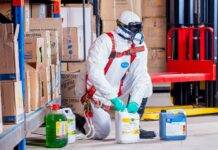
Safety Data Sheet Example
Introduction
What is a Safety Data Sheet?
Safety Data Sheets (SDS) are crucial documents outlining the hazards, safety measures, and handling procedures for substances used in various industries. They provide vital information for safety and regulatory compliance.
Importance
Regulatory Compliance
SDS serve as legal documents mandated by regulatory bodies. Compliance ensures safe handling, transport, and use of chemicals, protecting both individuals and the environment.
Components
Sections of an SDS
An SDS typically consists of sections detailing product identification, hazard identification, composition, first-aid measures, firefighting measures, accidental release measures, handling, and storage.
Structure
Format and Information
SDS follow a standardized format to present information uniformly. Each section provides specific details, ensuring clarity in understanding hazards and precautions.
Example
Sample SDS
An illustrative SDS example showcases the application of sections, delineating potential hazards, safety measures, and emergency protocols.
Usage
Industries and Applications
Various sectors like manufacturing, healthcare, agriculture, and transportation rely on SDS to ensure safety in handling chemicals, fostering a secure work environment.
Creating an SDS
Steps to Develop an SDS
Developing an SDS involves meticulous gathering of information, hazard assessment, documentation, and validation to produce accurate and comprehensive safety guidelines.
Here's an example of a Safety Data Sheet (SDS) for a hypothetical cleaning product:Safety Data Sheet
1. Identification
- Product Name: AllClean Super
- Manufacturer: CleanCo Industries
- Address: 1234 Cleaning Ave, Cityville, State, Zip
- Emergency Phone Number: 1-800-123-4567
2. Hazards Identification
- Classification of the substance or mixture: Skin Irritation (Category 2), Eye Irritation (Category 2A)
- Label Elements: Warning! Causes skin and eye irritation. Keep out of reach of children.
3. Composition/Information on Ingredients
- Chemical Name: Ingredient A
- Concentration: 15%
- CAS Number: 123-45-6
- Chemical Name: Ingredient B
- Concentration: 10%
- CAS Number: 789-12-3
4. First-Aid Measures
- Skin Contact: Wash affected areas thoroughly with soap and water. If irritation persists, seek medical attention.
- Eye Contact: Rinse eyes with water for 15 minutes. Remove contact lenses if present. Seek medical attention if irritation continues.
- Inhalation: Move to fresh air. If breathing difficulties occur, seek medical attention.
5. Fire-Fighting Measures
- Suitable Extinguishing Media: Use foam, carbon dioxide, dry chemical, or water fog.
- Hazards from Combustion: May release toxic fumes (carbon monoxide, carbon dioxide).
- Special Firefighting Procedures: Wear self-contained breathing apparatus and full protective gear.
6. Accidental Release Measures
- Personal Precautions: Wear protective equipment. Avoid breathing vapors. Ventilate the area.
- Cleanup Procedures: Absorb spillage with inert material. Dispose of according to local regulations.
7. Handling and Storage
- Handling: Use in well-ventilated areas. Avoid direct contact with skin and eyes. Wash hands after handling.
- Storage: Store in a cool, dry place away from heat and direct sunlight.
8. Exposure Controls/Personal Protection
- Respiratory Protection: Use appropriate respirator if ventilation is inadequate.
- Eye Protection: Wear safety glasses or goggles.
- Skin Protection: Use gloves and protective clothing.
9. Physical and Chemical Properties
- Appearance: Clear liquid
- Odor: Citrus
- pH: 6.5
- Melting Point: N/A
- Boiling Point: N/A
- Flash Point: >100°C
10. Stability and Reactivity
- Stability: Stable under normal conditions.
- Incompatibility: Avoid contact with strong acids or bases.
- Hazardous Decomposition Products: None under normal use.
11. Toxicological Information
- Acute Toxicity: LD50 (Oral, Rat) >5000 mg/kg
12. Ecological Information
- Eco-Toxicity: No data available.
13. Disposal Considerations
- Dispose of according to local regulations. Do not flush into drains or waterways.
14. Transport Information
- Not regulated for transportation.
15. Regulatory Information
- Follow all local, regional, and national regulations.
16. Other Information
- This Safety Data Sheet is prepared according to the standards of [Regulatory Authority].
Note: This is a general example and might not cover all aspects of a specific product's Safety Data Sheet. It's important to consult the actual SDS provided by the manufacturer for detailed and accurate information.Best Practices
Ensuring Accuracy
Maintaining accuracy in SDS creation involves regular updates, thorough research, and adherence to regulatory standards, guaranteeing reliable information for users.
Training
SDS Understanding
Conducting training sessions enhances understanding, ensuring proper comprehension and utilization of SDS within organizations.
Safety Measures
Utilizing SDS
Implementing the recommendations outlined in SDS promotes a culture of safety, mitigating risks associated with chemical handling.
SDS Management
Organization and Access
Efficiently organizing and ensuring accessible SDS facilitates quick retrieval and reference during emergencies, streamlining safety protocols.
Updates
Revisions and Relevance
Regularly updating SDS content maintains relevance, reflecting any changes in regulations or product formulations, thus ensuring the accuracy of safety information.
Conclusion
Summarizing Importance
Safety Data Sheets are indispensable tools for ensuring safety, regulatory compliance, and informed decision-making in various industries, safeguarding lives and the environment.
What is the First Step in a COSHH Assessment?
What is the Number 1 Golden Rule in COSHH?
Unique FAQs:
- Why are Safety Data Sheets important? Safety Data Sheets outline crucial information about hazardous substances, aiding in safe handling and regulatory compliance.
- Who requires Safety Data Sheets? Industries involving the use, transport, or handling of hazardous materials are mandated to have and utilize Safety Data Sheets.
- How often should Safety Data Sheets be updated? SDS should be updated regularly, especially when there are changes in regulations or product formulations, to ensure accuracy.
- What should one do if there’s an error in an SDS? Errors in SDS should be rectified immediately by updating the document and ensuring all users are informed about the changes.
- Are Safety Data Sheets accessible to the public? While SDS is primarily for employees handling hazardous substances, they might be accessible to the public upon request in compliance with regulations.
























